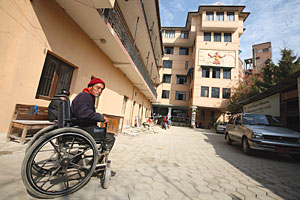In Nepal, those without the means too often have to resort to poorly equipped and managed state services. In the absence of state health insurance, for instance, all medical costs must be borne privately. Thanks to a range of factors including disruptive unions and the demands of the urban middle class, costs have risen across the board.
Health experts suggest a broad schedule of subsidies to make healthcare cheaper. "We need a system of graded subsidies - with subsidies lowest for the rich and highest for the poor - to ensure greater access to healthcare," says public health expert Saroj Dhital of Kathmandu Model Hospital.
But there are problems. The government is strapped for cash, with healthcare expenditure at a meagre $7 per capita, and private hospitals have little incentive to offer such concessions.
Community-run health cooperatives like Chhetrapati Free Clinic offer a creative solution. They operate 'micro-insurance' schemes, whereby patients contribute to a fund that subsidises healthcare for everyone in the community. Since the biggest contributors are usually the wealthiest, the scheme channels resources from the rich to the poor, much like a graded subsidy. Community oversight also reduces unnecessary costs.
"Cooperatives can certainly improve healthcare delivery. Kathmandu Model Hospital has helped many communities get started already," says Dhital. But health cooperatives require substantial external support. Nearly two thirds of Chhetrapati Free Clinic's expenses last year were met by external donors. "While they can help a lot of people, they aren't sustainable on a large scale," says President Bijay Bahadur Mali.
Initiatives funded by private donors, such as the Samata School, represent a replicable model to provide high-quality, cheap education to disadvantaged Nepalis. PestalozziWorld works across the world and in Nepal to provide scholarships to children from economically disadvantaged backgrounds.
Community and charitable initiatives such as the Chhetrapati Free Clinic, Samata School and PestalozziWorld don't absolve the state of its responsibilities towards its citizens. Neither do they detract from the top-quality, if expensive, services that the private sector can provide. But in providing alternatives to those with little choice at their disposal, they represent brave efforts to ensure all Nepalis reach their potential.
Affordable healthcare
 KIRAN PANDAY |
A doctor's visit, plus a follow-up meeting, costs just Rs75. This fee is waived for those who cannot pay. Community members oversee the clinic through an executive committee.
The facilities are first rate. Ear-Nose-Throat specialist Premal Kumar Joshi says, "I see about 40 patients a day and have the technology and equipment to provide a wide range of services." CFC provides basic medical care and will soon install two operation theatres.
In 2000, CFC set up Nepal's first modern dental lab. "We ushered Nepali dentistry into the 21st century. Our products and technicians are the best in the country," says President Bijay Bahadur Mali.
It may also be one of the few clinics standing in the event of an earthquake. One of its four buildings is earthquake-proof and volunteers have been trained to act as emergency medical aides.
But CFC faces steep challenges ahead. Doctors are hard to retain since they can earn much more in private clinics. Despite its facilities, CFC will struggle to keep up with advances in medical technology.
Bamboo school
 MIN RATNA BAJRACHARYA |
Thirty-five-year-old Uttam Sanjel (right) started Samata School in 2001 after a short film career. Today, it is on the cusp of becoming the world's cheapest and largest school.
It may also be the only school made entirely of bamboo.
Thanks to donations provided by local businesspeople and charitable organisations, Samata charges a mere Rs 100 in annual school fees from nursery to Class 10. There are 18,000 students in 11 campuses across 11 districts. The last batch all passed the SLC with distinction.
The secret is the attention teachers lavish upon individual students. "As soon as a student has a problem, the teacher corrects it," says Sanjel. This is possible because there are just 30 students per class.
The students are flocking in. Class 10 student Prakriti Mahara was encouraged to join by her sister, and doesn't regret it one bit. "Even if I got a scholarship at a private school, I would stay here," she says.
Eight more campuses will open in the next few years to accommodate an expected 24,000 additional students. If all goes according to plan, Samata will pass City Montessori School in Lucknow, India to become the world's largest school.
Samata recently won the 'Shining World Compassion Award', along with a $10,000 cheque, and the Manav Adhikar Puraskar.
READ ALSO:
Head, heart and hands - FROM ISSUE #488 (05 FEB 2010 - 11 FEB 2010)


